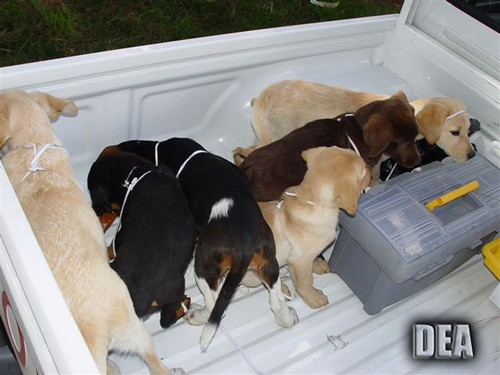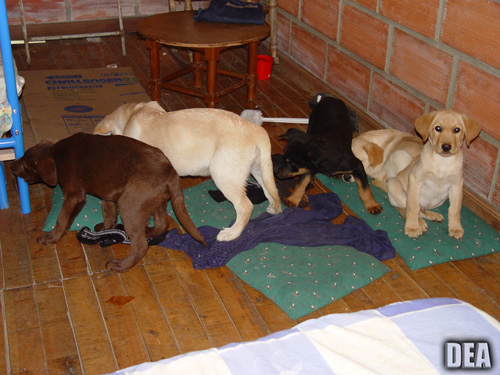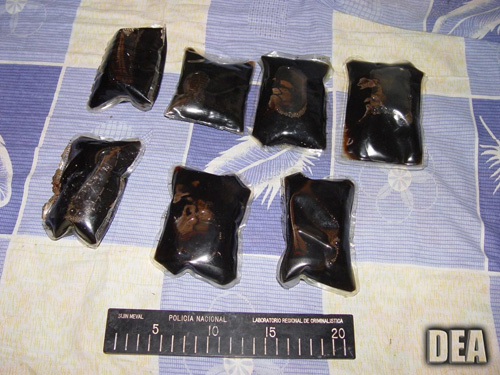Increased Penalties for Pet ‘lemon laws’ Debated
February 16, 2009

The Connecticut legislature is discussing a significant increase in the penalties against pet shops who sell diseased or defective dogs and cats. The current law calls for reimbursement up to $200 for veterinary care, clearly an inadequate figure given the typical costs of a visit to the vet in this state.
The Westport Coalition Against Puppy Mills is calling for a penalty that would be twice the purchase price of the animal. Since purchasers spend from $1,000 to $3,000 for ‘purebred’ dogs that come from these mills, the dealers that act as middle-men or the pet stores and chains that sell them directly this penalty would have a real impact on their profits.
Typical problems associated with dogs from Pennsylvania puppy mills sold in CT include the mild, kennel cough and intestinal ailments to the chronic and genetic, pneumonia and hip dysplasia.
The WCAPM site is packed with solid information and resources to learn more about this issue. Please check them out to educate yourself and help stop this awful ‘industry.’
Shelters full, Donations and Adoptions Down
October 20, 2008
The New York Times has run an article, (here) about a topic we’ve talked about before: how the financial crisis is affecting pet owners and shelters. As we know, the news is not good. Owners who can no longer afford to keep their pets, shelter adoption rates dropping, shelter workers stressed to the max.
For those who can keep their dogs or cats, Betsy Saul, founder of Petfinder.com offers this hopeful note: “They comfort us; they don’t care if your 401(k) lost money today. They’re one of the few people in the family who are not going to be stressed out about what you did with your money.”
Financial Pinch Affects Pet Care for Many
June 9, 2008
Here are some options to pursue if a coping with a medical condition affecting your dog is beyond your budget in today’s tight economy.
Foreclosure Pets: to adopt your next dog, please go local
April 8, 2008
The current housing crisis has added another unwanted phrase to the national lexicon: foreclosure pets.
Even in good economic times there’s a significant percentage of people who move and leave their pets behind. Most local shelters have a standing policy of not accepting “owner surrendered” pets for fear of being overwhelmed.
This doesn’t prevent these abandoned dogs and cats from ending up in shelters; the most common technique is to remove the dog’s tags and collar and set it loose two towns away. The idea is that before the dog could find its way back to familiar turf, it will be spotted, reported and picked up by animal control. And believe it or not, these people are giving their dogs a better chance than most. Too often families move and leave their pets behind; tied up in the yard, locked in basements and closets.
The most common reason given for surrendering a family pet is “We’re moving.” Now shelters are starting to hear: “I lost my house.”
While going through the stress of losing their home and figuring out the next step for themselves, families often forget the obligation they undertook when the got their pet. Some may believe (wrongly) that local officials or the bank that has taken over their property will shelter and provide for the dog they left behind. Or perhaps a neighbor.
There are also people who consider their pets disposable, like so much else in Today’s Modern World.®
In almost every state pets are considered personal property. They have no rights granted them or inherent protection. While it may be admirable to try and save these animals, shelter them, feed them, treat them for medical conditions and try and re-home them, there is generally no legal requirement to do so.
In most towns as long as there aren’t roving packs of feral dogs loping across Main Street at noon, they consider the canine problem well-managed.
Abandoned dogs face some pretty stiff odds. If they’re locked in the house when the owners depart they may die of dehydration. A dog, like a man, can go longer without food than without fresh water. If they’re left outside they may be leashed or tied where they are open to attack by local predators. They may also injure themselves trying to break free. Once free they are still prone to attack by predators, car strikes, starvation, and disease.
I saw a pit bull once whose neck was shaved completely around, a four-inch wide swath. Running around at the center of this stubbled skin was a bright red gash — it marked the place where a rope had been tied around its neck. The rope became embedded in the dog’s skin. The pit had been found tied to a porch at an abandoned house. On his journey from the vet’s office to the local shelter I was asked to take care of this dog, briefly.
As I sat near him I felt all the things that make people afraid of this breed. This dog was clearly powerful, heavily muscled, and easily 100 pounds. There was that wide jaw, rightly feared for its ability to lock in place and refuse to release once bitten. There was no leash or collar, so I really had no way to control the dog or keep him near me, if he chose to leave. Or to protect myself. I was sitting on a wooden bench, and this unfamiliar pitt bull was sitting in front of me, with his back to me, between my legs, and panting rapidly. A dog, I was starting to think, that had been severely neglected, and probably abused, by people. People just like me. If I was him, would I be suspicious of me? Might I want to show this stranger just how tough I am? If he did attack me, I could easily justify it in several ways from his point of view.
Just as I was starting to get a bit concerned, he turned his head over his shoulder and smiled at me, baring all his teeth and a little drool. At least I chose to interpret it as a smile. I curled in the fingers of my right hand and slowly offered the back of my hand for him to sniff.
Of course, you know the end of this story by now: he licked my hand and in another moment I was happily scratching him around his ears, just as if we was old pals.
What I take from this experience (and others) is that dogs, even though they have been horribly treated by humans, are almost always ready to give us a second chance; to begin a relationship, to offer companionship. A child treated the way this pit bull had been would never completely recover from the experience. It might even turn a child into a small, amoral monster. I’ve seen that happen, too.
I’m humbled by the fact that the canine race seems so willing to forgive the human race our cruel treatment of them.
So if you are looking for a dog right now, please go to your local animal shelter first to see if they might have the dog of a lifetime for you. If you strike out there, go to the next town over and then the town after that. If you’re lucky enough to have a county facility, try there.
At this moment, the sub-prime mortgage crisis means that there are thousands of great dogs flooding into the local shelter system. The odds for most of them being re-homed are narrow. Make a difference. To adopt your next dog, go local.
Give a great dog a second chance.
Dogs as Livestock in South Korea
April 3, 2008
The Australian Herald Sun is reporting that the Seoul city government is trying again to classify dogs as livestock in a bid to legalize, license, and regulate the industry and raise health standards for consumers.
Estimates of somewhere between 2 and 4 million dogs are eaten in South Korea each year; in Seoul alone there are about 500 dog meat restaurants. Other estimates say that nationwide there are 6,000 restaurants serving dogs and they are enjoyed by 10% of the population. Since there is no current regulation the market is underground. Almost all of these dogs are slaughtered and processed in less than pristine, sanitary conditions, making dog meat a somewhat risky entree for diners.
If this proposal is made law and effectively enforced, it could produce a rise in consumption as restaurant goers grew more confident that the dog meat they were ordering is ‘safe,’ that is, free of pathogens and other contaminants.
There is local opposition. Lee Won-Bok, president of the Korea Association for Animal Protection said, “It’s horrible to imagine dog meat on display next to beef and ham at supermarkets. It would also be nauseating to see roasted dog meat on the menu of your restaurant.”
However, Won-Bok’s statement seems to ignore the fact that dog meat is already consumed in fairly large quantities nation wide and is currently on many restaurant menus. Keeping this industry underground invites abusive and inhumane treatment.
The ethics here seems quite clear: if you are going to serve dog meat, consumers should be protected by making sure that meat is processed under sanitary conditions.
I wonder what the status of bestiality laws are in South Korea? Is it illegal to have sex with dogs but OK to roast and eat them?
Research science tells us that dogs and pigs rank very close to each other on scales of intelligence and gentleness. If you arrived from another planet and observed conditions in a factory farm that raises and slaughters pigs and then saw how some people are practicing Yoga with their companion dogs, you would be quite appropriately confused.
The distinction drawn here is simply cultural and not based on biology.
As a consumer of pork and a platonic, non-sexual lover of dogs, I recognize the weakness of any moral outrage I might muster over this dichotomy. No one likes to accept the fact that their moral position is arbitrary and based on locale and not any set of hard facts.
But to pretend otherwise is a lie.
Dogs in Danger.com
February 11, 2008
DogsinDanger.com is a new non-profit organization devoted to saving the millions of dogs who are running out of time in local shelters all across the country. No one group, or single approach can stem this tide of killing abandoned dogs. But this is certainly a step in the right direction.
James Serpell, author of the excellent book In the Company of Animals estimates that we euthanize less than 5% of the US canine population each year. So while the percentage is small, the absolute number is still unconscionably high.
The truth is we are doing better today than we were in the 1970s and 1980s when the estimates were around 13 million dogs killed a year. But we must drive this number down further. Dogsindanger.com is one way to do that. Check them out if you are interested in adopting a dog and saving a life.
–from their website:
WHO ARE WE
DogsInDanger.com is a nonprofit national shelter outreach program at the forefront of a grassroots movement trying to help shelters save the lives of millions of innocent dogs.
A NATIONAL TRAGEDY
We are a nation of dog lovers. Then why is it that the shelters that are expected to provide these animals with a second chance at life are instead being forced to euthanize them?
Shelters are the last line for millions of innocent dogs. The public has no idea of the magnitude of this national tragedy. The sad reality is that over four million dogs are killed each year in shelters. Why, in a country of dog lovers, are so many dogs homeless?
Because their families abandon them, for reasons like job change, divorce and new baby… and most shelters don’t have the necessary programs to get the dogs the exposure they need to find new homes. Shelters find homes for many dogs, but millions are euthanized. For far too long we have been told there is no other way.
AND A REASON FOR HOPE
DogsInDanger.com believes in the power of compassion, and that Americans would do more to help and adopt shelter dogs, if only they knew how many dogs shelters were forced to euthanize. We also believe that shelters don’t really want to euthanize dogs, if they had any other option. Simply put, we have chosen a path of technology as a means of connecting these scared, abandoned shelter dogs with the loving homes they deserve. As a nonprofit organization, we seek no other gain except for the happiness we see in the face of a dog as he faithfully walks out through the shelter doors, in perfect step with his loving new family.
It may be uncomfortable for some to see lists of names and photos of dogs scheduled to be euthanized, but, the truth is uncomfortable. By making it personal, we believe more people will be compelled to help these dogs. Thus dogsindanger.com refuses to present a sanitized version of the truth. Our ultimate goal is to see a day where healthy and treatable animals are no longer killed by their most trusted friends.
Heroin Puppies
February 2, 2008
Heroin Traffickers Used Puppies to Smuggle Drugs Medellin-based Organization Surgically Implanted Packets of Heroin in Pure-Bred Dogs
Feb. 3, 2006: The DEA arrested 22 heroin traffickers based out of Medellin, Colombia, who used puppies to smuggle drugs. The drug traffickers surgically implanted packets of liquid heroin into purebred dogs. All of the puppies who survived were adopted by local families and are still doing well today.
DEA has received numerous calls concerning the fate of the puppies who survived the horrific deeds of drug smugglers. Many of the callers expressed interest in adopting the dogs. We are pleased to report that all of the puppies have been taken in by Columbian families and are in great health. The public reaction to this story has been overwhelming. We thank you all for your interest.
— from the DEA’s website




